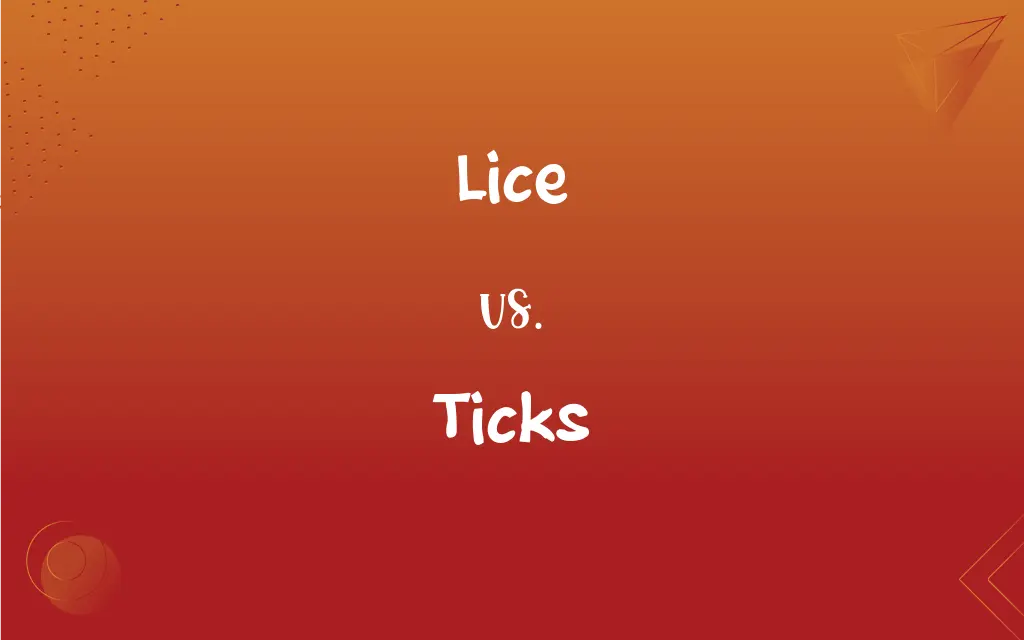Lice vs. Ticks: What's the Difference?
Edited by Aimie Carlson || By Harlon Moss || Published on January 29, 2024
Lice are small, wingless insects infesting hair or feathers; ticks are larger, arachnid parasites attaching to skin.

Key Differences
Lice are tiny, wingless insects that live on the skin of mammals and birds, feeding on blood or dead skin. They are specific to their hosts and often cause itching. Ticks, on the other hand, are arachnids, related to spiders, and attach themselves to various animals, including humans, to feed on blood. They can transmit diseases and are generally found in wooded or grassy areas.
Lice have a lifecycle that is entirely dependent on their host and includes nits (lice eggs), nymphs, and adults. They are highly contagious among individuals with close contact. Ticks, conversely, have a more complex life cycle with four stages - egg, larva, nymph, and adult - and can survive for long periods without a host.
The physical appearance of lice is small and flat, making them adept at hiding in hair or feathers. They cause irritation but are not known for transmitting diseases. Ticks, however, are larger and can be seen with the naked eye when engorged with blood. They are notorious for transmitting serious illnesses such as Lyme disease.
Treatment for lice typically involves topical insecticides and thorough cleaning of bedding and clothing. Combing to remove nits is also a common practice. In contrast, ticks are best removed with tweezers, ensuring the entire tick is extracted, and the area is cleaned to prevent infection.
Prevention strategies for lice include avoiding sharing personal items like combs or hats, while tick prevention involves using repellents, wearing protective clothing, and performing regular tick checks after being in infested areas.
ADVERTISEMENT
Comparison Chart
Classification
Insects
Arachnids
Size
Very small
Larger, visible when engorged
Habitat
Hair, feathers
Skin, outdoor environments
Disease Transmission
Rarely transmit diseases
Known for disease transmission
Life Cycle
Simple, host-dependent
Complex, can survive off-host
ADVERTISEMENT
Lice and Ticks Definitions
Lice
Lice feed on blood or skin debris, causing itching.
The presence of lice caused severe itching on her scalp.
Ticks
Ticks are known carriers of diseases like Lyme disease.
Lyme disease is a common concern in areas with a high tick population.
Lice
In historical contexts, lice were common concerns in trenches or crowded living conditions.
Soldiers during the war often battled with lice in the trenches.
Ticks
Ticks require careful removal to prevent infection.
Use tweezers to remove a tick, ensuring no part is left in the skin.
Lice
Lice can refer to a problem or nuisance in a metaphorical sense.
His constant questions were like lice, annoying and persistent.
Ticks
Ticks are small, blood-sucking arachnids often found in wooded areas.
He found a tick on his leg after walking through the forest.
Lice
Lice are small, parasitic insects infesting hair or feathers.
Children in school often undergo checks for head lice.
Ticks
Ticks attach to their hosts' skin, feeding on their blood.
Removing a tick quickly is crucial to prevent disease transmission.
Lice
Lice infestations require thorough treatment and cleaning.
They had to wash all their clothes and bedding to get rid of the lice.
Ticks
Ticks can survive for long periods without feeding.
A tick can live for months without a host to feed on.
Lice
Plural of louse.
Ticks
A light, sharp, clicking sound made repeatedly by a machine, such as a clock.
Ticks
Chiefly British A moment.
FAQs
Can lice transmit diseases?
Lice are not known to transmit diseases.
How do you get lice?
Lice are typically spread through direct contact with an infested person or their belongings.
Can pets get lice?
Pets can get a specific type of lice, different from those affecting humans.
How are lice treated?
Lice are treated with topical insecticides and thorough cleaning of affected items.
Can ticks transmit diseases?
Yes, ticks can transmit diseases like Lyme disease and Rocky Mountain spotted fever.
What are lice?
Lice are small, wingless insects that infest hair or feathers, causing itching.
What are ticks?
Ticks are blood-sucking arachnids that can attach to skin and transmit diseases.
Can lice jump or fly?
No, lice cannot jump or fly; they spread by direct contact.
How can you prevent tick bites?
Use tick repellents, wear protective clothing, and perform regular tick checks after outdoor activities.
Are lice contagious?
Yes, lice are highly contagious, especially among children in close-contact settings.
How can you check for ticks?
After being outdoors, thoroughly check your body, clothing, and pets for ticks.
Where are ticks commonly found?
Ticks are often found in wooded, grassy, or brushy areas, as well as on animals.
Are there different types of ticks?
Yes, there are many types of ticks, including deer ticks, dog ticks, and Lone Star ticks.
Do all ticks carry diseases?
Not all ticks carry diseases, but many are capable of transmitting various illnesses.
Can lice infestations lead to other health issues?
While lice themselves do not cause serious health issues, excessive scratching can lead to skin infections.
How long can ticks live?
Some ticks can live several years, depending on the species and environmental conditions.
How should a tick be removed?
Remove ticks using fine-tipped tweezers, grasping the tick as close to the skin as possible and pulling straight out.
What is the life cycle of lice?
The lice life cycle includes three stages: nit (egg), nymph, and adult.
What are common symptoms of lice infestation?
Common symptoms include itching, visible nits on hair, and a feeling of something moving in the hair.
Can ticks survive indoors?
Ticks can survive indoors for short periods, especially in humid environments, but they generally prefer outdoor habitats.
About Author
Written by
Harlon MossHarlon is a seasoned quality moderator and accomplished content writer for Difference Wiki. An alumnus of the prestigious University of California, he earned his degree in Computer Science. Leveraging his academic background, Harlon brings a meticulous and informed perspective to his work, ensuring content accuracy and excellence.
Edited by
Aimie CarlsonAimie Carlson, holding a master's degree in English literature, is a fervent English language enthusiast. She lends her writing talents to Difference Wiki, a prominent website that specializes in comparisons, offering readers insightful analyses that both captivate and inform.































































